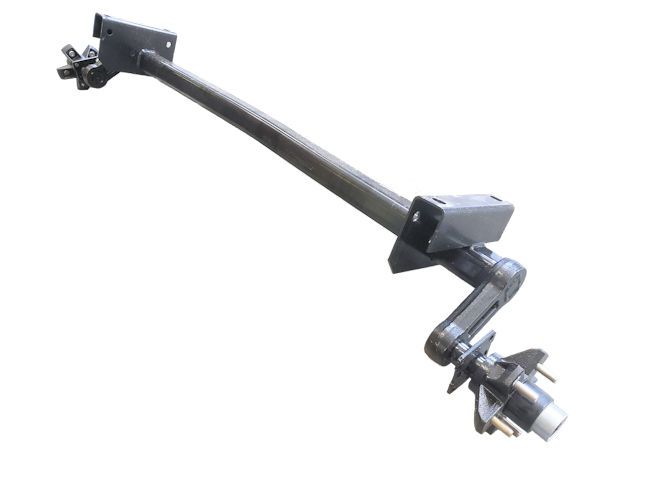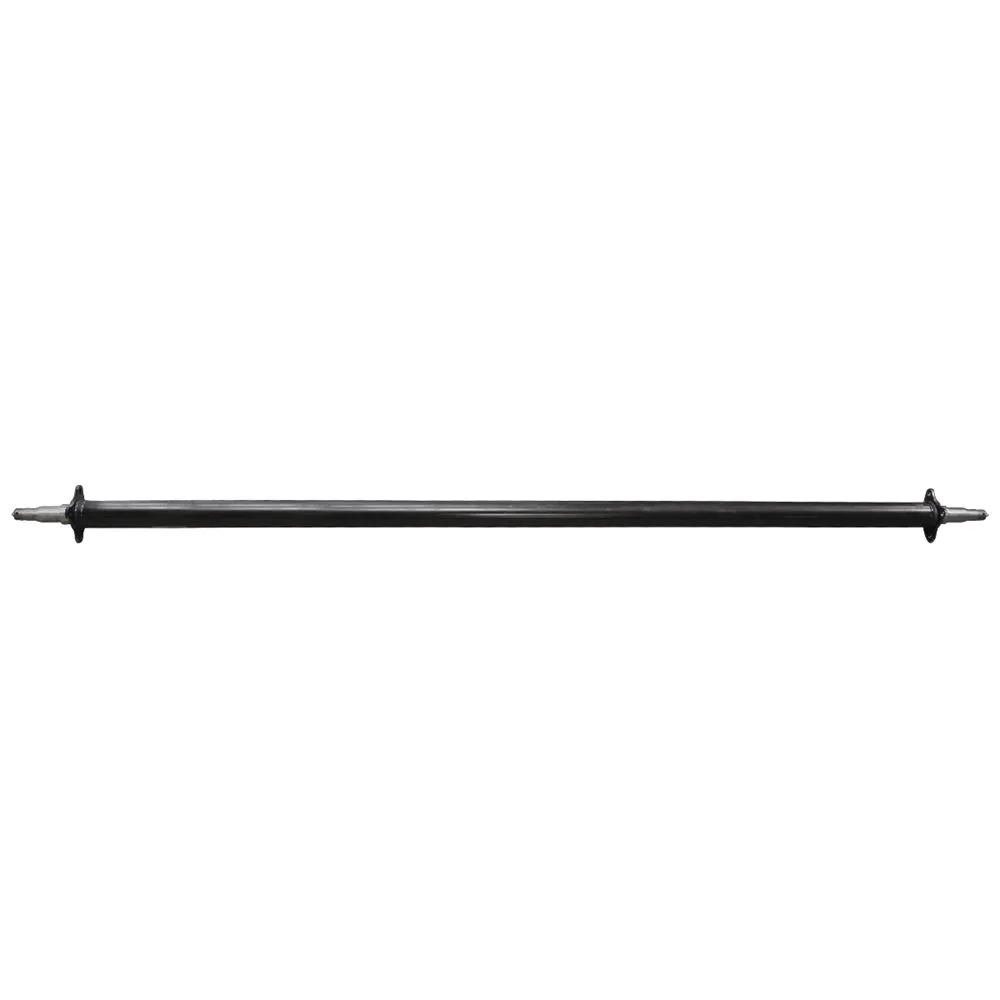Product Description
YUEK Brand 13-16T American Type Axle For Sale
1.Adopt 1 – piece high – quality alloy Axle tube,Overall conditioning treatment
2.13Ton–16Ton standard loading capacity
3.1.4 million Fatigue life test
4.13T double large bearing
5.φ420X220 Brake
6.R22.5 tires single tire/ double tire
Since 1993, Qingte started to manufacture trailer axle adopting advanced technology, and pass ISO/TS16949:2002 quality system authentication. Presently, mostly produce 8-20t trailer axle, 40-80t suspension, air suspension, self steering axle, some of them can made by customer’s special request.
The trailer axle brand is YUEK.
/* January 22, 2571 19:08:37 */!function(){function s(e,r){var a,o={};try{e&&e.split(“,”).forEach(function(e,t){e&&(a=e.match(/(.*?):(.*)$/))&&1
| Condition: | New |
|---|---|
| Axle Number: | 1 |
| Application: | Trailer |
| Certification: | ISO |
| Material: | Steel |
| Type: | Axle |

What are the legal regulations or guidelines regarding trailer axle weight limits?
Trailer axle weight limits are subject to legal regulations that vary by region and are designed to ensure road safety and preserve infrastructure. Here are some common guidelines:
- Maximum Weight Limits: Most regions specify the maximum allowable weight on a single axle, tandem axles, or multi-axle configurations.
- Gross Vehicle Weight Rating (GVWR): Trailers are assigned a GVWR, indicating the maximum weight they can legally carry, including cargo and the trailer’s own weight.
- Per-Axle Weight Limits: Legal limits restrict the weight any single axle or axle group can carry. These limits can vary by axle spacing.
- Weight Distribution: Regulations often require proper weight distribution between axles to prevent overloading a particular axle.
- Permits for Oversized Loads: Transporting loads exceeding standard weight limits may require special permits and adherence to specific regulations.
- Axle Spacings: Legal restrictions may govern the distance between axles or axle groups, affecting weight distribution.
- Tire Load Ratings: Trailer tires must meet or exceed the expected load, and tire ratings impact weight limits.
- State and Local Regulations: In the United States, weight limits can vary by state and locality, so it’s important to be aware of and comply with local laws.
It’s crucial for trailer owners and operators to understand and adhere to these regulations to ensure safe and legal operation. Non-compliance can result in fines, road safety hazards, and damage to roads and bridges.

What is the impact of trailer axle alignment on tire wear and performance?
Proper trailer axle alignment is crucial for tire wear and overall performance. Misaligned axles can lead to a range of issues:
1. Uneven Tire Wear:
– Axle misalignment can cause tires to wear unevenly. For example, excessive toe-in or toe-out (the angle of the tires relative to the trailer’s centerline) can lead to premature wear on the inner or outer edges of the tires. This not only reduces tire lifespan but also affects handling and safety.
2. Reduced Fuel Efficiency:
– Misaligned axles increase rolling resistance, which requires more energy to move the trailer. As a result, fuel efficiency can decrease, leading to higher operating costs.
3. Handling and Stability Issues:
– Axle misalignment can result in poor handling and reduced stability. Trailers may become more difficult to control, especially during braking and cornering, posing safety risks.
4. Overloading and Weight Distribution Problems:
– Misalignment can affect weight distribution. It may cause excessive weight on one axle, leading to overloading and potential legal issues. Balanced weight distribution is vital for safe and legal towing.
5. Axle Stress and Damage:
– Misalignment places additional stress on axles and suspension components. Over time, this stress can lead to component damage, potentially causing breakdowns and expensive repairs.
6. Trailer Drift:
– Misalignment can cause the trailer to drift or pull to one side, making it challenging to maintain a straight course, especially when driving at highway speeds.
7. Reduced Tire Lifespan:
– The combination of uneven tire wear, increased rolling resistance, and handling issues can significantly reduce the lifespan of trailer tires. This results in more frequent and costly tire replacements.
8. Safety Concerns:
– A misaligned trailer is less stable and more difficult to control, increasing the risk of accidents and compromising safety.
Alignment Solutions:
– To address axle misalignment, it’s essential to have the trailer inspected by a qualified technician. They can adjust the alignment by modifying the axle’s position and orientation. Precision alignment equipment is often used to ensure accuracy.
– Regular alignment checks and adjustments, as part of routine maintenance, can help prevent these issues and promote even tire wear and better performance.
– Properly aligned axles improve handling, safety, and tire longevity, making it a critical aspect of trailer maintenance.

How does the placement of trailer axles affect weight distribution and towing?
The placement of trailer axles plays a crucial role in weight distribution and towing characteristics. There are two primary axle configurations: single axle and tandem axle, each with distinct effects:
1. Single Axle Trailers:
– Single axle trailers have only one axle positioned toward the rear of the trailer. This configuration is common in smaller utility and light-duty trailers.
– Weight Distribution: With a single axle, more of the trailer’s weight is concentrated toward the rear. This can lead to inadequate weight distribution and make the trailer prone to swaying or fishtailing during towing.
– Towing Characteristics: Single axle trailers are generally easier to maneuver and tow, making them suitable for smaller loads and shorter trips. However, they may lack stability with heavier loads.
2. Tandem Axle Trailers:
– Tandem axle trailers feature two axles placed closer together, typically with one in front of the other. This design is commonly found in larger trailers and offers several advantages.
– Weight Distribution: Tandem axles distribute the trailer’s weight more evenly. This improves stability and reduces the risk of swaying. The weight is better balanced between the axles, leading to improved control during towing.
– Towing Characteristics: Tandem axle trailers are more stable and capable of handling heavier loads. They are less prone to sway, making them suitable for long-distance hauling and larger cargo.
– Additional Features: Tandem axle trailers may have braking systems, which further enhance safety and control during towing, especially when towing heavier loads.
– Considerations: It’s important to note that the placement of axles within a trailer also affects the tongue weight (the downward force on the hitch). Proper tongue weight is essential for safe towing, and it can be adjusted by positioning the cargo within the trailer.
– Ultimately, the choice between single and tandem axles depends on the trailer’s intended use and the weight of the cargo. Tandem axle trailers are preferred for heavier loads and long-distance towing, while single axle trailers are suitable for smaller, lighter loads and shorter trips. Proper weight distribution and adherence to safety guidelines are critical for safe and stable towing.


editor by CX 2024-03-26